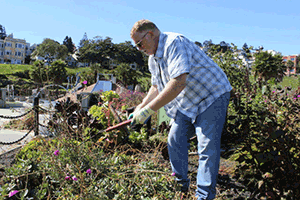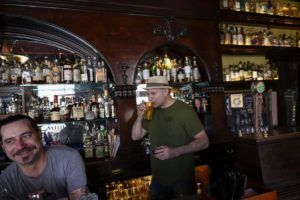Garden club has first workday at Dolores Park
In an effort to enhance beauty and promote safety, the Dolores Park Garden Club has been formed to, among other things, build and sustain flower beds throughout the park. Under the direction of volunteer Robert Brust, a small group recently gathered near the park’s Helen Diller playground to prune, pick, and pluck.

“This is one of park and rec’s babies,” said Brust, referring to the San Francisco Recreation and Park Department while standing inside a bioretention flower bed constructed earlier this year. Bioretention planters are planted depressions designed to collect and absorb runoff.
Under Rec and Park’s supervision, the bioretention flower bed sits near the base of several Guadalupe palm trees, which stayed in place during the park’s $20.5 million renovation that was completed in early 2016. Added during construction, underground pipes guide natural spring water from the hillside of Dolores Heights and Castro Hill to the enclosed flower bed.
“With the slightest amount of rain, this thing bursts into water,” said Brust of the bioretention area, which was strategically placed near the children’s park for educational purposes.
The Dolores Park Garden Club had three volunteers and two Rec and Park employees during its first workday September 28. It’s a project of Rec and Park, Dolores Park Works, and the Dolores Park Ambassadors.
“I love the park,” said volunteer Kim O’Connor, a lesbian who has lived in the Dolores Park area for almost 30 years. “I’m here weeding and pruning and looking forward to planting later.”
Volunteer Tom Shaub, a gay man, has seen the transformation of the park since moving to the area in 1991. “We’re making the community aware they need to be involved. There’s been so much trash accumulating since the rebirth,” he said.
The volunteers agreed that the August shooting on the pedestrian bridge, which wounded three people, has decreased community interest in the park. So far, police have announced no arrests.
“The horrible shooting was a symptom of a problem,” Brust said. “The park needs people to pay attention to it.”
Brust, a gay man, said he and his partner got involved in the park soon after they moved to nearby Liberty Street 12 years ago. He said that he “spent the first five years just picking up trash and talking to people,” which allowed him to meet his neighbors.
“If you just take your children and flee when the park gets overrun, it goes feral,” said Brust. “[Since the shooting], there’s not enough energy near the bridge and it’s an opportunity for the LGBTQ community to do stuff in the park.”
Brust feels it’s important to bring a strong LGBTQ presence into Dolores Park again, noting that he misses the Sisters of Perpetual Indulgence’s Easter Sunday Hunky Jesus contests. Due to the park’s renovation, the Sisters moved their annual Easter festivities to Golden Gate Park’s Hellman Hollow in 2015.
“This is a good first start,” Brust said of the garden club’s inaugural workday. “We’re trying to make this a sustainable effort, a real club that keeps [the community] engaged.”
Dolores Park Ambassadors, a community group supporting the garden club, encouraged neighbors, visitors, dog walkers, and concerned citizens to take an active role in making Dolores Park a clean and safe environment for everyone.
“There’s plenty of areas in the park for us to really get involved in,” Brust added. “The overall trash problem has gone down, but [broken] glass is a big problem. It’s difficult for gardeners to pick up. Children and dogs are at risk, too.”
In September, the Board of Supervisors approved a ban on glass containers in all San Francisco parks. However, the most controversial aspect of the legislation, a proposed $1,000 fine for littering and dumping in Dolores Park, was tabled due to the effect it could have on low-income residents.
“There’s still a lot of work left,” Brust said.


